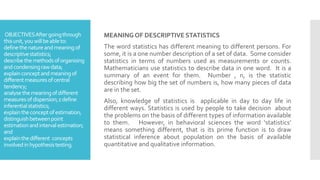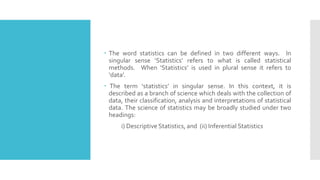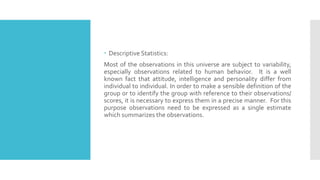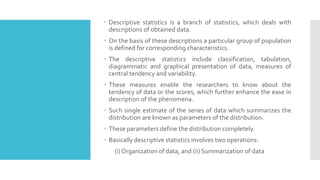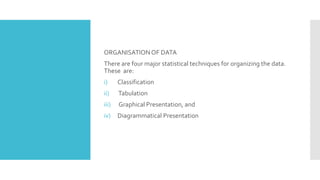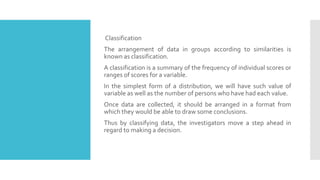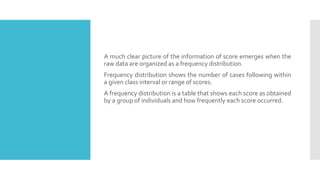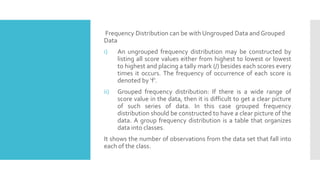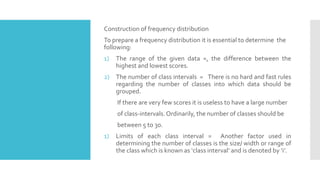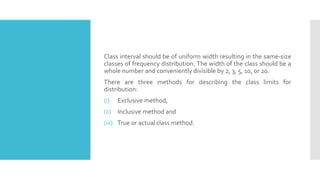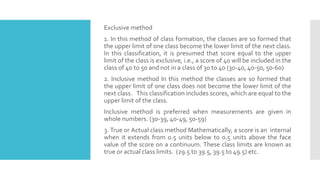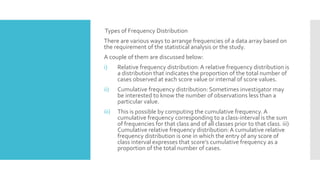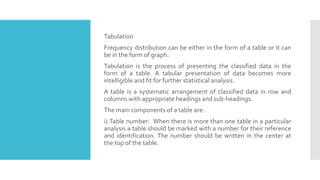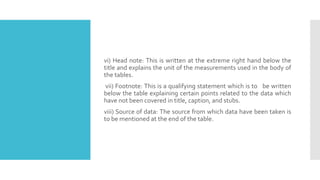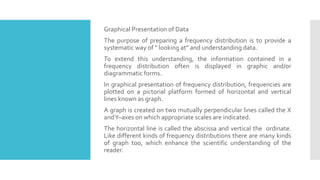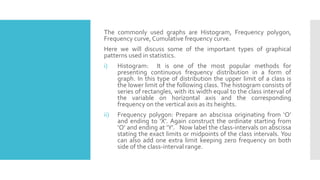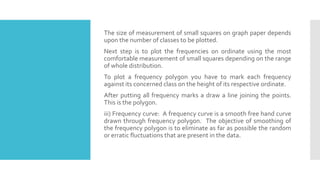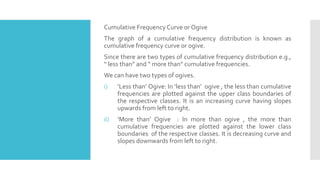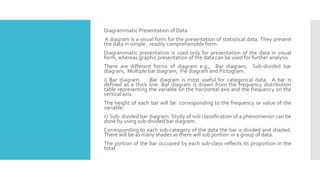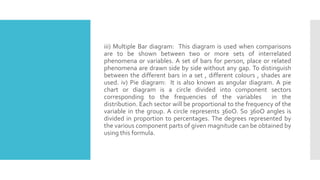Intoduction to statistics
- 1. Statistics Dr. Nagarajan Srinivasan, CEO and Director (Research) CGN Research World
- 2. MEANING OF DESCRIPTIVE STATISTICS The word statistics has different meaning to different persons. For some, it is a one number description of a set of data. Some consider statistics in terms of numbers used as measurements or counts. Mathematicians use statistics to describe data in one word. It is a summary of an event for them. Number , n, is the statistic describing how big the set of numbers is, how many pieces of data are in the set. Also, knowledge of statistics is applicable in day to day life in different ways. Statistics is used by people to take decision about the problems on the basis of different types of information available to them. However, in behavioral sciences the word ‘statistics’ means something different, that is its prime function is to draw statistical inference about population on the basis of available quantitative and qualitative information. OBJECTIVESAftergoingthrough thisunit,youwillbeableto: definethenatureandmeaningof descriptivestatistics; describethemethodsoforganising andcondensingrawdata; explainconceptandmeaningof differentmeasuresofcentral tendency; analysethemeaningofdifferent measuresofdispersion;zdefine inferentialstatistics; explaintheconceptofestimation; distinguishbetweenpoint estimationandintervalestimation; and explainthedifferent concepts involvedinhypothesistesting.
- 3. The word statistics can be defined in two different ways. In singular sense ‘Statistics’ refers to what is called statistical methods. When ‘Statistics’ is used in plural sense it refers to ‘data’. The term ‘statistics’ in singular sense. In this context, it is described as a branch of science which deals with the collection of data, their classification, analysis and interpretations of statistical data. The science of statistics may be broadly studied under two headings: i) Descriptive Statistics, and (ii) Inferential Statistics
- 4. Descriptive Statistics: Most of the observations in this universe are subject to variability, especially observations related to human behavior. It is a well known fact that attitude, intelligence and personality differ from individual to individual. In order to make a sensible definition of the group or to identify the group with reference to their observations/ scores, it is necessary to express them in a precise manner. For this purpose observations need to be expressed as a single estimate which summarizes the observations.
- 5. Descriptive statistics is a branch of statistics, which deals with descriptions of obtained data. On the basis of these descriptions a particular group of population is defined for corresponding characteristics. The descriptive statistics include classification, tabulation, diagrammatic and graphical presentation of data, measures of central tendency and variability. These measures enable the researchers to know about the tendency of data or the scores, which further enhance the ease in description of the phenomena. Such single estimate of the series of data which summarizes the distribution are known as parameters of the distribution. These parameters define the distribution completely. Basically descriptive statistics involves two operations: (i) Organization of data, and (ii) Summarization of data
- 6. ORGANISATIONOF DATA There are four major statistical techniques for organizing the data. These are: i) Classification ii) Tabulation iii) Graphical Presentation, and iv) Diagrammatical Presentation
- 7. Classification The arrangement of data in groups according to similarities is known as classification. A classification is a summary of the frequency of individual scores or ranges of scores for a variable. In the simplest form of a distribution, we will have such value of variable as well as the number of persons who have had each value. Once data are collected, it should be arranged in a format from which they would be able to draw some conclusions. Thus by classifying data, the investigators move a step ahead in regard to making a decision.
- 8. A much clear picture of the information of score emerges when the raw data are organized as a frequency distribution. Frequency distribution shows the number of cases following within a given class interval or range of scores. A frequency distribution is a table that shows each score as obtained by a group of individuals and how frequently each score occurred.
- 9. Frequency Distribution can be with Ungrouped Data and Grouped Data i) An ungrouped frequency distribution may be constructed by listing all score values either from highest to lowest or lowest to highest and placing a tally mark (/) besides each scores every times it occurs. The frequency of occurrence of each score is denoted by ‘f’. ii) Grouped frequency distribution: If there is a wide range of score value in the data, then it is difficult to get a clear picture of such series of data. In this case grouped frequency distribution should be constructed to have a clear picture of the data. A group frequency distribution is a table that organizes data into classes. It shows the number of observations from the data set that fall into each of the class.
- 10. Construction of frequency distribution To prepare a frequency distribution it is essential to determine the following: 1) The range of the given data =, the difference between the highest and lowest scores. 2) The number of class intervals = There is no hard and fast rules regarding the number of classes into which data should be grouped. If there are very few scores it is useless to have a large number of class-intervals.Ordinarily, the number of classes should be between 5 to 30. 1) Limits of each class interval = Another factor used in determining the number of classes is the size/ width or range of the class which is known as ‘class interval’ and is denoted by ‘i’.
- 11. Class interval should be of uniform width resulting in the same-size classes of frequency distribution. The width of the class should be a whole number and conveniently divisible by 2, 3, 5, 10, or 20. There are three methods for describing the class limits for distribution: (i) Exclusive method, (ii) Inclusive method and (iii) True or actual class method.
- 12. Exclusive method 1. In this method of class formation, the classes are so formed that the upper limit of one class become the lower limit of the next class. In this classification, it is presumed that score equal to the upper limit of the class is exclusive, i.e., a score of 40 will be included in the class of 40 to 50 and not in a class of 30 to 40 (30-40, 40-50, 50-60) 2. Inclusive method In this method the classes are so formed that the upper limit of one class does not become the lower limit of the next class. This classification includes scores, which are equal to the upper limit of the class. Inclusive method is preferred when measurements are given in whole numbers. (30-39, 40-49, 50-59) 3. True or Actual class method Mathematically, a score is an internal when it extends from 0.5 units below to 0.5 units above the face value of the score on a continuum. These class limits are known as true or actual class limits. (29.5 to 39.5, 39.5 to 49.5) etc.
- 13. Types of Frequency Distribution There are various ways to arrange frequencies of a data array based on the requirement of the statistical analysis or the study. A couple of them are discussed below: i) Relative frequency distribution:A relative frequency distribution is a distribution that indicates the proportion of the total number of cases observed at each score value or internal of score values. ii) Cumulative frequency distribution: Sometimes investigator may be interested to know the number of observations less than a particular value. iii) This is possible by computing the cumulative frequency. A cumulative frequency corresponding to a class-interval is the sum of frequencies for that class and of all classes prior to that class. iii) Cumulative relative frequency distribution:A cumulative relative frequency distribution is one in which the entry of any score of class interval expresses that score’s cumulative frequency as a proportion of the total number of cases.
- 14. Tabulation Frequency distribution can be either in the form of a table or it can be in the form of graph. Tabulation is the process of presenting the classified data in the form of a table. A tabular presentation of data becomes more intelligible and fit for further statistical analysis. A table is a systematic arrangement of classified data in row and columns with appropriate headings and sub-headings. The main components of a table are: i) Table number: When there is more than one table in a particular analysis a table should be marked with a number for their reference and identification. The number should be written in the center at the top of the table.
- 15. Title of the table: Every table should have an appropriate title, which describes the content of the table. The title should be clear, brief, and self-explanatory. Title of the table should be placed either centrally on the top of the table or just below or after the table number. iii) Caption: Captions are brief and self-explanatory headings for columns. Captions may involve headings and sub-headings. The captions should be placed in the middle of the columns. For example, we can divide students of a class into males and females, rural and urban, high SES and Low SES etc. iv) Stub: Stubs stand for brief and self-explanatory headings for rows. v) Body of the table: This is the real table and contains numerical information or data in different cells. This arrangement of data remains according to the description of captions and stubs.
- 16. vi) Head note: This is written at the extreme right hand below the title and explains the unit of the measurements used in the body of the tables. vii) Footnote: This is a qualifying statement which is to be written below the table explaining certain points related to the data which have not been covered in title, caption, and stubs. viii) Source of data: The source from which data have been taken is to be mentioned at the end of the table.
- 17. Title Stub Head Stub Entries Caption Column Head I Column Head II Sub Head Sub Head Sub Head Sub Head Main Body of the Table Total Foot Note(s): Source
- 18. Graphical Presentation of Data The purpose of preparing a frequency distribution is to provide a systematic way of “ looking at” and understanding data. To extend this understanding, the information contained in a frequency distribution often is displayed in graphic and/or diagrammatic forms. In graphical presentation of frequency distribution, frequencies are plotted on a pictorial platform formed of horizontal and vertical lines known as graph. A graph is created on two mutually perpendicular lines called the X andY–axes on which appropriate scales are indicated. The horizontal line is called the abscissa and vertical the ordinate. Like different kinds of frequency distributions there are many kinds of graph too, which enhance the scientific understanding of the reader.
- 19. The commonly used graphs are Histogram, Frequency polygon, Frequency curve, Cumulative frequency curve. Here we will discuss some of the important types of graphical patterns used in statistics. i) Histogram: It is one of the most popular methods for presenting continuous frequency distribution in a form of graph. In this type of distribution the upper limit of a class is the lower limit of the following class. The histogram consists of series of rectangles, with its width equal to the class interval of the variable on horizontal axis and the corresponding frequency on the vertical axis as its heights. ii) Frequency polygon: Prepare an abscissa originating from ‘O’ and ending to ‘X’. Again construct the ordinate starting from ‘O’ and ending at ‘Y’. Now label the class-intervals on abscissa stating the exact limits or midpoints of the class intervals. You can also add one extra limit keeping zero frequency on both side of the class-interval range.
- 20. The size of measurement of small squares on graph paper depends upon the number of classes to be plotted. Next step is to plot the frequencies on ordinate using the most comfortable measurement of small squares depending on the range of whole distribution. To plot a frequency polygon you have to mark each frequency against its concerned class on the height of its respective ordinate. After putting all frequency marks a draw a line joining the points. This is the polygon. iii) Frequency curve: A frequency curve is a smooth free hand curve drawn through frequency polygon. The objective of smoothing of the frequency polygon is to eliminate as far as possible the random or erratic fluctuations that are present in the data.
- 21. Cumulative Frequency Curve or Ogive The graph of a cumulative frequency distribution is known as cumulative frequency curve or ogive. Since there are two types of cumulative frequency distribution e.g., “ less than” and “ more than” cumulative frequencies. We can have two types of ogives. i) ‘Less than’ Ogive: In ‘less than’ ogive , the less than cumulative frequencies are plotted against the upper class boundaries of the respective classes. It is an increasing curve having slopes upwards from left to right. ii) ‘More than’ Ogive : In more than ogive , the more than cumulative frequencies are plotted against the lower class boundaries of the respective classes. It is decreasing curve and slopes downwards from left to right.
- 22. Diagrammatic Presentation of Data A diagram is a visual form for the presentation of statistical data. They present the data in simple , readily comprehensible form. Diagrammatic presentation is used only for presentation of the data in visual form, whereas graphic presentation of the data can be used for further analysis. There are different forms of diagram e.g., Bar diagram, Sub-divided bar diagram, Multiple bar diagram, Pie diagram and Pictogram. i) Bar diagram: Bar diagram is most useful for categorical data. A bar is defined as a thick line. Bar diagram is drawn from the frequency distribution table representing the variable on the horizontal axis and the frequency on the vertical axis. The height of each bar will be corresponding to the frequency or value of the variable. ii) Sub- divided bar diagram: Study of sub classification of a phenomenon can be done by using sub-divided bar diagram. Corresponding to each sub-category of the data the bar is divided and shaded. There will be as many shades as there will sub portion in a group of data. The portion of the bar occupied by each sub-class reflects its proportion in the total.
- 23. iii) Multiple Bar diagram: This diagram is used when comparisons are to be shown between two or more sets of interrelated phenomena or variables. A set of bars for person, place or related phenomena are drawn side by side without any gap. To distinguish between the different bars in a set , different colours , shades are used. iv) Pie diagram: It is also known as angular diagram. A pie chart or diagram is a circle divided into component sectors corresponding to the frequencies of the variables in the distribution. Each sector will be proportional to the frequency of the variable in the group. A circle represents 360O. So 360O angles is divided in proportion to percentages. The degrees represented by the various component parts of given magnitude can be obtained by using this formula.
- 24. After the calculation of the angles for each component, segments are drawn in the circle in succession, corresponding to the angles at the center for each segment. Different segments are shaded with different colors, shades or numbers.

